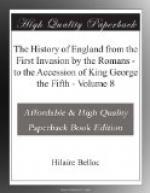[Footnote 1: Thurloe, iv. 571. See also 582, 589, 594. Carte’s Letters, ii. 87, 90, 92, 95.]
[Footnote 2: Thurloe, v. 67, 133.]
[Footnote 3: Ibid. i. 726-730; v. 68, 113, 257, 286. Vaughan, i. 446.]
[Sidenote a: A.D. 1657. March 5.] [Sidenote b: A.D. 1657. March 15.] [Sidenote c: A.D. 1657. April 15.] [Sidenote d: A.D. 1657. May 29.] [Sidenote e: A.D. 1657. June 10.] [Sidenote f: A.D. 1657. July 10.] [Sidenote g: A.D. 1657. Sept. 10.]
these he destroyed four, and captured two, one of which was laden, with treasure. Montague, who came home with the prize, valued it in his despatch at two hundred thousand pounds; the public prints at two millions of ducats; and the friends of Cromwell hailed the event “as a renewed testimony of God’s presence, and some witness of his acceptance of the engagement against Spain."[1]
The equipment of this fleet had exhausted the treasury, and the protector dared not impose additional taxes on the country at a time when his right to levy the ordinary revenue was disputed in the courts of law. On the ground that the parliamentary grants were expired, Sir Peter Wentworth had refused to pay the assessment in the country, and Coney, a merchant, the duties on imports in London. The commissioners imposed fines, and distrained; the aggrieved brought actions against the collectors. Cromwell, indeed, was able to suppress these proceedings by imprisoning the counsel and intimidating their clients; but the example was dangerous; the want of money daily increased; and, by the advice of the council, he consented to call a parliament to meet on the 17th of September.[2]
[Footnote 1: Thurloe, 399, 433, 509, 524. Carte’s Letters, ii. 114. It appears from a letter of Colonel White, that the silver in pigs weighed something more than forty thousand pounds, to which were to be added some chests of wrought plate.—Thurloe, 542. Thurloe himself says all was plundered to about two hundred and fifty thousand pounds, or three hundred thousand pounds sterling (557). The ducat was worth nine shillings.]




